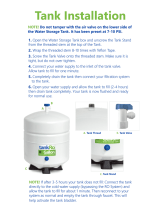
Table of Contents
Water Softener Safety .......................................................................... 3
Before You Start ............................................................................... 3
Inspect Shipment .............................................................................. 4
Water Softener Dimensions ..................................................................... 5
How a Water Softener Works .................................................................... 5
Softening Cycle ............................................................................ 5
Regeneration Cycle ......................................................................... 5
Water Conditioning Information .................................................................. 6
Water Conditioning ......................................................................... 6
Installation Requirements ....................................................................... 8
Location Requirements ...................................................................... 8
Tools and Parts Needed ..................................................................... 8
Air Gap Requirements ...................................................................... 9
Valve Drain Requirements ................................................................... 8
Plan the Installation ............................................................................ 10
Inlet - Outlet Plumbing Options .............................................................. 10
Installation Instructions ......................................................................... 11
Turn Off Water Supply ....................................................................... 11
Install Brine Tank Overflow Elbow ............................................................. 11
Move the Water Softener into Place ........................................................... 12
Assemble Inlet and Outlet Plumbing .......................................................... 13
Connect Inlet and Outlet Plumbing ........................................................... 13
Install Valve Drain Hose ..................................................................... 14
Install Salt Storage Tank Overflow Hose ....................................................... 14
Test for Leaks .............................................................................. 15
Add Water and Salt to the Salt Storage Tank ................................................... 15
Sanitize the Water Softener!Sanitize After Service ............................................... 15
Plug In the Water Softener ................................................................... 15
Program the Water Softener ..................................................................... 16
Set Time of Day ............................................................................ 16
Set Water Hardness Number ................................................................. 17
Set Recharge (Regeneration) Time ........................................................... 17
Set Salt Type ............................................................................... 17
Start a Recharge ........................................................................... 18
Customize Features/Options .................................................................... 19
Recharge .................................................................................. 19
Recharge Scheduled / Tonight ............................................................... 19
Set Salt Level .............................................................................. 19
Tank Light ................................................................................. 20
Timer "Power-Outage Memory" . ............................................................ 20
Water Flow Indicator ........................................................................ 20
Salt Efficiency .............................................................................. 20
Clean / Clear Water Iron Removal ............................................................ 21
Clean Feature Minutes ...................................................................... 21
Maximum Days Between Regenerations ....................................................... 22
12 or 24 Hour Clock ........................................................................ 22
Routine Maintenance ........................................................................... 23
Refilling With Salt ........................................................................... 23
Breaking A Salt Bridge ...................................................................... 23
Cleaning the Nozzle and Venturi .............................................................. 24
Troubleshooting Guide ......................................................................... 25
Automatic Electronic Diagnostics ............................................................. 26
Manual Advance Diagnostics ................................................................ 26
Manual Advance Regeneration Check ........................................................ 27
Wiring Schematic .............................................................................. 29
Warranty ...................................................................................... 29
Softener Components .......................................................................... 30




















